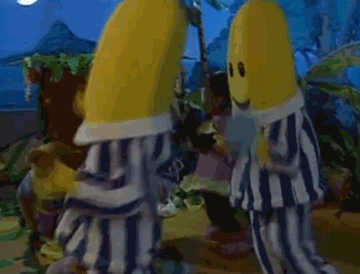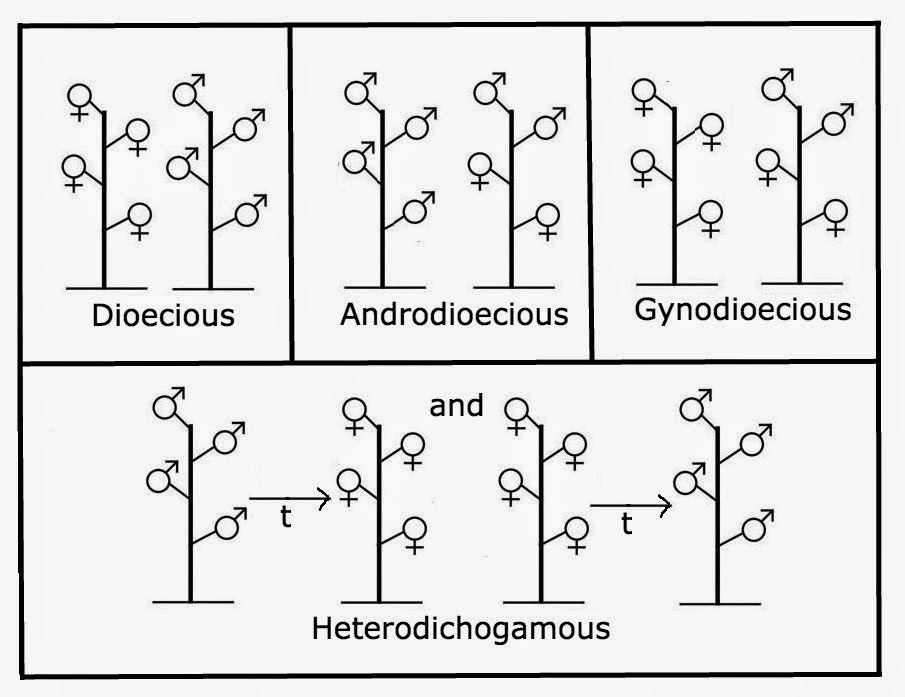Biology concepts – dioecy, heterodichogamy, diphasy, plant breeding systems, evolution, botany
DNA sequence can include of a lot of A’s, C’s, T’s, and G’s that are not in coding regions. The genes are sequences of DNA that code for a specific product, not just a run of nucleotides. The genes of the banana and man may be different in sequence (slightly to moderately), but they each code for a protein that does the same job. Overall, it’s easier to find DNA that matches outside of genes because there is so much of it (humans have about 2% of their DNA invested in genes).
Still, 25% similarity in genes is pretty amazing, though some people are truly bananas and should be better matches. In reality, we aren’t that different from any organism that descended from those first algae that moved on to land.
Our molecular biology is very similar to plants. Consider all the genes responsible for making DNA, proteins, modifying all the different biomolecules, and making energy in the form of ATP. In those ways, we are almost identical to plants. True, most plants do some things we can’t, like photosynthesis. And we do some things they can’t, like calculus and making videos of cats playing the piano, but our biochemistry is remarkably similar.
One way in which plants and animals are often different is that about 99% of animal species have two separate groups of individuals – guys and gals. Sure, there are the exceptions, and we have talked about some, but for the most part animal species have separate sexes.
several ways to be monoecious last week, there are several systems in which the sexes are divided amongst different individuals – called dioecy. Having separate male and female plants makes an angiosperm dioecious.
But before we get to the ways of being dioecious, we better look at one mysterious exception, called subdioecy. It’s hard to define, because it’s hard to tell if it is real or not. Subdioecy is really just what scientists call it when they can’t tell what they’re looking at. Most succinctly, subdioecy is when a dioecious plant has flowers that aren’t clearly male or female. And that may be because the flower hasn’t decided what it wants to be, speaking on an evolutionary scale, of course.
Flowers that are in the middle of becoming bisexual after being unisexual for a long time, or those hermaphrodites that are just starting to lose male or female structures will be hard to define as male, female, or bisexual. The structures might be there, but be small, they may not look like the typical structures, or they may be there but be non-functional.
All these would be reasons to classify a plant as subdioecious. However, if a species keeps functional hermaphrodites and its unisexual plants in a stable system (over time), then that’s another exception that we can talk about next week. Three sexes, you say?
But for now, let’s move on to the more definable exceptions, the first of which is the situation when there are clear-cut female and male plants.
Dioecy– About 4% of flowering plants have individual male and female plants, but the incidence is higher on island systems than on continents. Hmmm. We talked a couple of weeks ago about how areas that are relatively resource poor, ie. dirt with fewer nutrients or areas of less water or higher stress, seem to promote development of maleness. It turns out that they promote dioecy as well.
Whatever the reason, it seems that dioecious plants compete better in nutrient poor or stressed soils. If this is true, then you would also expect to find a higher than normal percentage of dioecious plants in tropical rain forests and along sandy beaches near salt water (high salt is a stressful environment). Does it work out that way?
Yep, many studies have discussed a higher percentage of dioecious plants on island systems. A 2005 paper extended this to a portion of SE Brail that is resource poor because it is rain forest (most of the nutrients are tied up in large trees) and because it is sandy soil near the beaches. In this locale, fully 32% of species are dioecious – that’s a huge number compared with a normal range of 4-6%.
The reason may be that by dividing the duties of the plants - males producing pollen and females producing ovules and then seeds – the resource needs of any one plant is lower. Some of each will survive and keep the species going. Once again, it’s related to males doing better in stressed situations.
Androdioecous– This breeding system is related to that situation above. In androdioecy, there are male plants and hermaphroditic plants. The unisexual males can colonize more territory and produce a lot of pollen to ensure that the bisexual flowers get pollinated. On the other hand, a single hermaphrodite can produce several plants on its own, so it is good for colonizing new territory.
Gynodioecy– I’m guessing you can figure out what this system must be like. Female plants and hermaphroditic plants coexist in one population. This system is more advantaged when resources are plentiful, so in areas of fertile soil, these species will gain a better foothold and out compete gynodioecious species.
In fact, gynodioecy is much more common than androdioecy. This may result from a pollen saving strategy, especially in areas where nitrogen is limited (pollen uses a lot of nitrogen). More likely, it is preferred because it gives more chances for seed production (more females). But whatever the case, both gynodioecy and androdioecy are considered to be important systems because they probably represent a transition between monoecious and dioecious systems.
This begs the questions as to which was first, monoecy or dioecy. Several recent reviews talk about the evolution of dioecy from monoecious plants, with stop-overs in gynomonoecy, andromonoecy, gynodioecy or andromonoecy. A 2012 review shows that we have good evidence for the first step – monoecy to gynodioecy, but little evidence of the second step – gynodioecy to dioecious.
see this post).
Heterodichogamy– This breeding system is the dioecious version of dichogamay we talked about last week. Here, the males turn into females and the females plants become male, but the two populations are out of phase. The timing is crucial so that cross pollination is accomplished.
An example is the Zizyphus jujuba. This tree has individuals that are male in morning and female in afternoon. Another set of individuals in the same population are male in late afternoon and female in morning. So there is always a female to accept the pollen being made by males and the possibility of self-pollination is reduced almost entirely.
A more perplexing example of heterodichogamous breeding system is found in a 2014 study of Platycarya strobilacea (family Juglandaceae). Most plants in this family of walnut trees are wind pollinated, but in this one case, pollination occurs via a thrip insect.
It may be that the dichogamy in dioecious plants occurs in just one of the populations of individuals. Now the names start getting long. Heterodichogamous androdioecious– one population is male while the other is first male then female. Some maple trees were thought to exist in this system, but a 2007 study by Renner cast doubt on the earlier observations and reclassified many as dichogamous or duodichogamous monecious (see last weeks post). On the other hand, there are no recorded instances of heterodichogamous gynodioecious (females and females that turn male). Do you have any ideas why?
Next week, a final flower breeding exception. Not one, not two, but three stable sexes in one population of flowering plants. Trioecy is the reason we have dyed silk and tropical fruit salad.
Matallana, G., Wendt, T., Araujo, D., & Scarano, F. (2005). High abundance of dioecious plants in a tropical coastal vegetation American Journal of Botany, 92 (9), 1513-1519 DOI: 10.3732/ajb.92.9.1513
For more information classroom activities, see:
Dioecy –
see last week’s list of links (here)
Evolution of dioecy –





